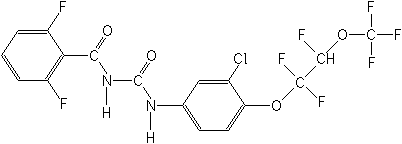|
Return to
Index Page
Adverse Effects
ACTIVITY:
Insecticide (Benzoylurea)
CAS Name:
N-[[[3-chloro-4-[1,1,2-trifluoro-2-(trifluoromethoxy)ethoxy]phenyl]amino]carbonyl]-2,6-
difluorobenzamide
Structure:

http://www.ncbi.nlm.nih.gov/entrez/query.fcgi?db=pubmed&cmd=Retrieve&dopt=AbstractPlus&list_uids=16786494&query_hl=1&itool=pubmed_docsum
Pest
Manag Sci. 2006 Aug;62(8):752-8.
Hazards
and uptake of chitin synthesis inhibitors in bumblebees
Bombus terrestris.
Mommaerts
V, Sterk G, Smagghe G.
Department
of Biology, Faculty of Sciences, Free University of Brussels,
Brussels, Belgium.
This
research project examined the potential hazards of a major
class of insect growth regulators (IGRs) to survival, reproduction
and larval growth in bumblebees Bombus terrestris L. Eight
chitin synthesis inhibitors (CSIs) were tested: buprofezin,
cyromazine, diflubenzuron, flucycloxuron,
flufenoxuron, lufenuron, novaluron
and teflubenzuron. These
different IGRs, which are important in the control of pest
insects in greenhouses, were applied via three different
routes of exposure under laboratory conditions: dermal contact,
and orally via the drinking of sugar/water and via pollen.
The compounds were tested at their respective maximum field
recommended concentrations (MFRC) and also in dose-response
assays to calculate LC(50) values. In general, none of the
CSIs showed acute worker toxicity. However,
there was a dramatic reduction in brood production, especially
after oral treatment with pollen and sugar/water.
Conspicuously, egg fertility was reduced
in all treatments with diflubenzuron and teflubenzuron.
In addition to egg mortality, the worker bumblebees removed
larvae from the treated nest, and in most cases these individuals
were dead first-second instars. Under a binocular microscope,
such larvae showed an abnormally formed cuticle leading
to mechanical weakness and death. In another series of experiments
using (14)C-diflubenzuron and (14)C-flufenoxuron, cuticular
penetration in workers was studied for a better understanding
of the differences in toxicity. With (14)C-diflubenzuron,
transovarial transport and accumulation in the deposited
eggs supported the strong reproductive effects. Overall,
the present results suggest that CSIs should be applied
with caution in combination with bumblebees. The
compatibility of each compound to be used in combination
with B. terrestris is discussed in relation to calculated
LC(50) values, routes of uptake and effects.
PMID:
16786494 [PubMed - indexed for MEDLINE]
NOTE
from FAN: 6 of the 8 pesticides tested
are fluorinated: diflubenzuron, flucycloxuron, flufenoxuron,
lufenuron, novaluron and teflubenzuron
|
http://www.ncbi.nlm.nih.gov/entrez/query.fcgi?db=pubmed&cmd=Retrieve&dopt=AbstractPlus&list_uids=16334340&query_hl=1&itool=pubmed_docsum
J Econ Entomol. 2005 Oct;98(5):1685-93.
Resistance potential of colorado potato
beetle (Coleoptera: Chrysomelidae) to novaluron.
Cutler GC, Tolman JH, Scott-Dupree CD, Harris CR.
Department of Environmental Biology, Ontario Agricultural College,
University of Guelph, Guelph, Ontario, Canada, N1G 2W1. cutler@uoguelph.ca
Novaluron (Rimon 10 EC), a novel insect growth regulator, could
play an important role in future management programs for Colorado
potato beetle, Leptinotarsa decemlineata (Say). Studies were conducted
to determine the potential of Colorado potato beetle to develop
resistance to novaluron before its widespread use in Colorado
potato beetle management. Second instars of an imidacloprid-resistant
Colorado potato beetle strain exhibited reduced susceptibility
(2.5-fold) to novaluron. The toxicity of novaluron to this strain
was synergized by S,S,S-tributyl phosphorotrithioate (DEF) but
not by piperonyl butoxide (PBO), suggesting that esterase-based
detoxification mechanisms were responsible for novaluron resistance.
Bioassays with treated potato foliage found that a single low-
or medium-rate novaluron application was highly persistent under
field conditions, resulting in up to 85% mortality of second instars
5 wk after treatment. Thus, intense selection pressure for novaluron-resistant
Colorado potato beetle may continue long after population densities
have been reduced below an economic threshold level. In a national
survey, the susceptibility of second instars to a novaluron diagnostic
dose was determined for 27 different field populations collected
from six Canadian provinces in summer 2003. Despite no previous
exposure to novaluron, mortalities at the diagnostic dose ranged
from 55 to 100%. Although novaluron has
several characteristics that should delay resistance development
in insect pests, these results highlight the need for judicious
use of the compound in management of Colorado potato beetle.
PMID: 16334340 [PubMed - indexed for MEDLINE]
|